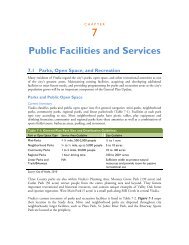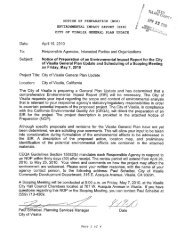General Plan Update Review Committee Draft Elements Part 2 For ...
General Plan Update Review Committee Draft Elements Part 2 For ...
General Plan Update Review Committee Draft Elements Part 2 For ...
Create successful ePaper yourself
Turn your PDF publications into a flip-book with our unique Google optimized e-Paper software.
Toxic Air Contaminants<br />
The ambient background of toxic air contaminants<br />
(TACs) is the combined result of many diverse<br />
human activities, including emissions from gasoline<br />
stations, automobiles, dry cleaners, industrial operations,<br />
hospital sterilizers, and painting operations.<br />
In 1987, the California State legislature enacted,<br />
through Assembly Bill 2588, the Air Toxics Hot Spots<br />
Information and Assessment Act, which requires<br />
companies in California to provide information<br />
to the public about emissions of toxic air contaminants<br />
and their possible impact on public health. The<br />
SJVAPCD implements this act through the local Air<br />
Toxics “Hot Spots” Program. Toxic air contaminants<br />
are pollutants that occur at relatively low concentrations<br />
and are associated with carcinogenic and other<br />
adverse health effects, but for which no ambient air<br />
quality standards have been established. Impact<br />
is measured as “maximum individual cancer risk”<br />
which is the likelihood that a person exposed to concentrations<br />
of TACs over a lifetime will develop cancer.<br />
As of 2011, there were no facilities located in the<br />
Visalia <strong>Plan</strong>ning Area identified as a significant risk. 1<br />
The Air Resources Board maintains an inventory<br />
of toxic air contaminants concentrations and their<br />
health risks. Total emissions in the year 2011 from<br />
stationary sources of TACs in the San Joaquin Valley<br />
included: 6,073 tons per year of diesel particulate<br />
matter, 4,065 tons per year of formaldehyde, 1,680<br />
tons per year of benzene, 1,602 tons per year of acetaldehyde,<br />
515 tons per year of butadiene, 404 tons per<br />
year of methylene chloride, 360 tons per year of per-<br />
1 San Joaquin Valley Air Pollution Control District, 2011 Annual<br />
Report on the District’s Air Toxics Program.<br />
chloroethylene, and 156 tons per year of para-dichlorobenzene.<br />
The SJVAPCD regulates toxic air contaminants<br />
from stationary sources through their permit process.<br />
Mobile sources of toxic air contaminants are<br />
regulated indirectly through vehicle emissions standards<br />
for reactive organic gas (ROG) and through<br />
fuel specifications. Cities play a role in reducing public<br />
exposure to TACs by enforcing zoning ordinances<br />
and ensuring proper buffer zones between stationary<br />
sources that emit toxic contaminants and sensitive<br />
receptors located down wind.<br />
Sensitive Receptors<br />
Some receptors are considered more sensitive than<br />
others to air pollutants. The reasons for greater than<br />
average sensitivity include pre-existing health problems,<br />
proximity to emissions source, or duration of<br />
exposure to air pollutants. Land uses such as schools,<br />
children’s day care centers, hospitals, and convalescent<br />
homes are considered to be more sensitive<br />
than the general public to poor air quality because<br />
the population groups associated with these uses<br />
have increased susceptibility to respiratory distress<br />
and other air quality-related health problems. Persons<br />
engaged in strenuous work or exercise also have<br />
increased sensitivity to poor air quality. Residential<br />
areas are considered more sensitive to air quality conditions<br />
than commercial and industrial areas, because<br />
people generally spend longer periods of time at their<br />
residences, resulting in greater exposure to ambient<br />
air quality conditions. Recreational uses are also considered<br />
sensitive, due to the greater exposure to ambient<br />
air quality conditions, and because the presence<br />
of pollution detracts from the recreational experience.<br />
DRAFT ELEMENTS<br />
<strong>For</strong> <strong>General</strong> <strong>Plan</strong> <strong>Update</strong> <strong>Review</strong> <strong>Committee</strong><br />
Land uses such as schools, children’s day care centers,<br />
hospitals, and convalescent homes are considered to<br />
be more sensitive than the general public to poor air<br />
quality.<br />
AUGUST 2012<br />
7-7




